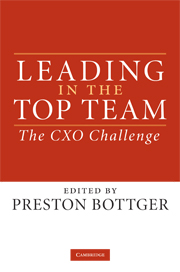Book contents
- Frontmatter
- Contents
- Figures
- Tables
- Contributors
- Editor's Acknowledgments
- 1 Introduction – Leading within and across the functions
- Section I The Business Imperatives
- Section II The CXOs: Within the Functions
- 5 The Chief Marketing Officer – Creating, delivering and communicating value to customers
- 6 The Chief Sales Officer – Sell, sell, sell!
- 7 The Chief Supply Chain Officer – Designing and managing lean and agile supply chains
- 8 The Chief Manufacturing Officer – Process execution, improvement and design
- 9 The Chief Financial Officer – A capital position
- 10 The Chief Technology Officer – Corporate navigator, agent of change and entrepreneur
- 11 The Chief Information Officer – Achieving credibility, relevance and business impact
- 12 The Chief Human Resources Officer – Delivering people who can deliver
- 13 The Corporate Governance Officer – From company secretary to manager of governance processes
- 14 The Chief Communications Officer – Leading strategic communications
- 15 The SBU President – Perhaps the best job for the CEO-in-training
- 16 CXOs and the Line – Serving the internal customer
- Section III The CEO and the Leadership Team – Pulling it all together
- Conclusion
- Index
- References
11 - The Chief Information Officer – Achieving credibility, relevance and business impact
Published online by Cambridge University Press: 19 August 2009
- Frontmatter
- Contents
- Figures
- Tables
- Contributors
- Editor's Acknowledgments
- 1 Introduction – Leading within and across the functions
- Section I The Business Imperatives
- Section II The CXOs: Within the Functions
- 5 The Chief Marketing Officer – Creating, delivering and communicating value to customers
- 6 The Chief Sales Officer – Sell, sell, sell!
- 7 The Chief Supply Chain Officer – Designing and managing lean and agile supply chains
- 8 The Chief Manufacturing Officer – Process execution, improvement and design
- 9 The Chief Financial Officer – A capital position
- 10 The Chief Technology Officer – Corporate navigator, agent of change and entrepreneur
- 11 The Chief Information Officer – Achieving credibility, relevance and business impact
- 12 The Chief Human Resources Officer – Delivering people who can deliver
- 13 The Corporate Governance Officer – From company secretary to manager of governance processes
- 14 The Chief Communications Officer – Leading strategic communications
- 15 The SBU President – Perhaps the best job for the CEO-in-training
- 16 CXOs and the Line – Serving the internal customer
- Section III The CEO and the Leadership Team – Pulling it all together
- Conclusion
- Index
- References
Summary
Information can be described as data endowed with relevance and purpose. It is through information about customers, competitors, operations and products that business value is created and performance improved. Effective usage of information is essential for executives to manage their companies and for businesses to create value.
In this chapter, the author explains that the CIO's role and significance are growing and evolving quickly. The challenges facing Chief Information Officers are explored in detail: developing the credibility of the IT organization, reorganizing IT to meet business priorities, and finding new ways for information to add value.
The role of the chief information officer
I feel my biggest challenge is to establish the credibility of the IT organization and function among the business unit managers of our group. Job one is to manage the IT investments and resources of the group in a cost-efficient and effective way, to deliver on our promises and commitments, and to move beyond being IT ‘mechanics’ to enablers of process and business change.
(Newly appointed CIO of a global industrial products group)What is unique about the CIO role? What business contributions could CIOs make to their company's success? Should the CIO be accepted as having a strategic leadership role or is it purely operational? The answers to these questions have become much clearer as organizations recognize the potential impact, significance and cost of information.
In the past, it has often been unclear whether the CIO role was simply another label for the head of information technology.
- Type
- Chapter
- Information
- Leading in the Top TeamThe CXO Challenge, pp. 204 - 222Publisher: Cambridge University PressPrint publication year: 2008
References
- 4
- Cited by

